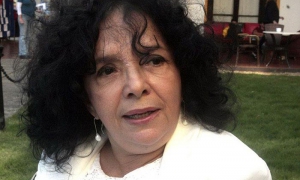
Leontina, the latest Cuban film to be released, directed by Rudy Mora, stands out for its use of photography, music, soundtrack, editing, and the performances, both of the child actors and the extraordinary cast of adult actors the director managed to secure.
This is Mora’s second film, a well-established producer of television series (Diana, Doble juego and La otra cara) and video clips. His debut film, Y sin embargo, 2012, also saw the use of children in key roles.
The new film saw a press screening at the capital’s Chaplin cinema, prior to its national release (June 22), followed by a press conference at the Fresa y Chocolate Cultural Center, with the participation, alongside Mora, of the directors of photography, Ernesto Calzado and sound design, Osmani Olivare, as well as actor Blanca Rosa Blanco, and one of the child actors, Olo Tamayo (from the La Colmenita children’s theater group, directed by Carlos Alberto Cremata, who played the role of Lapatún in Y, sin embargo).
The film includes various child actors: Edgar Valle, Najar Nellar, Carolina Díaz Padrón, Gian Carlos González and Maureen Altagracia, a seven year old from Haiti. Referring to Altagracia, Rudy Mora explained, “Because I wanted to emphasize communication between people, beyond the language barrier.”
As a summary of this rich and eventful story: a group of children participating in a painting competition need the color blue, but this can only be found in the town of Palma Blanca, a place where laughter has disappeared and a group called Los Magníficos governs. There, the people move slowly, except in the store El legionario, whose owner offers free candy. The children begin to reverse the state of things with their paintings.
The first question at the press conference related to the interest in the image the director wished to provide with this film. “I didn’t want a realistic film, or everyday points that allocate time or place, but yes, a contemporary language. I am interested in approaching certain issues of society and I do so through this visuality, unlinked to contemporaneity, and at the same time moving away from the testimonial, the here and now,” Mora explained.
Regarding the photography, director Ernesto Calzado spoke about finding this different image, and how he believed it could be achieved, “through the camera movement, background work, and color in post-production to highlight the difference moods.”

Leontina is certainly distinguished by a singular image, both due to these camera movements and the frames. In this sense, Mora revealed that together with Calzado, they painted each shot one by one, and added: “I put everything on the shooting script.”
However, considering the great actors in the film, was there any room provided for improvisation? “No, because I wanted to maintain a tone in their way of expressing themselves. It is true that this was complicated, because although all have made films, they come from the theater, and I needed an absence of expression and gesticulation.”
Blanca Rosa Blanco, a very well-known film and television actor, the only cast member present at the press conference, added: “I relied a lot on the director, because my character (like all) is unreal, appears out of nowhere, and I only had the script as reference.”
For Blanco, this is an ensemble film, where she shares the screen with Corina Mestre, Fernando Hechavarría, Jorge Ali, Nelson González, Hilario Peña, Michel Labarta, Cary Vera, Laura Treto, Sergio Buitrago, Giselle Gonzálezand Yaremis Pérez.
Particularly striking is the fleeting participation of leading actors, Alden Knight, José Corrales, Samuel Claxton, Norberto Blanco, Carlos Padrón and Frank González; dance figures such as Rosario Cárdenas, Irene Rodríguez and Miguel Iglesias; a musician of the caliber of Edesio Alejandro; and a maestro of contemporary Cuban art, Arturo Montoto.
Mora commented in this regard: “I see a problem in Cuban cinema, the repetitive use of actors. So I sought representative figures who, with a look or gesture, give rise to a situation. In the case of Montoto, he also collaborated with the painting the children had to do, while Rosario Cárdenas was quite a presence, and with her company contributed to the movement, she choreographed the slowness of the townspeople. All were committed to their discourse.”
Having learned about the photography, and selection and direction of actors, the original music by Juan Carlos Rivero and soundtrack by Olivare Osmani, two significant aspects of this new film, were addressed.

Rivero composed eight pieces for different situations, not characters, once the film was finished. “I requested that it sound symphonic, expressive, nostalgic,” Mora explained. Meanwhile, Olivare noted that from the sound point of view, it was difficult to create a fantasy world. “We are talking about creating atmospheres, sensations, in harmony with the music.”
There is much art in Leontina, a technically flawless film by Rudy Mora. He has said he didn't want to focus on making films for any particular audience, be it children or adults, but, as the slogan of the film itself reads, “Those who play, want to win.”






